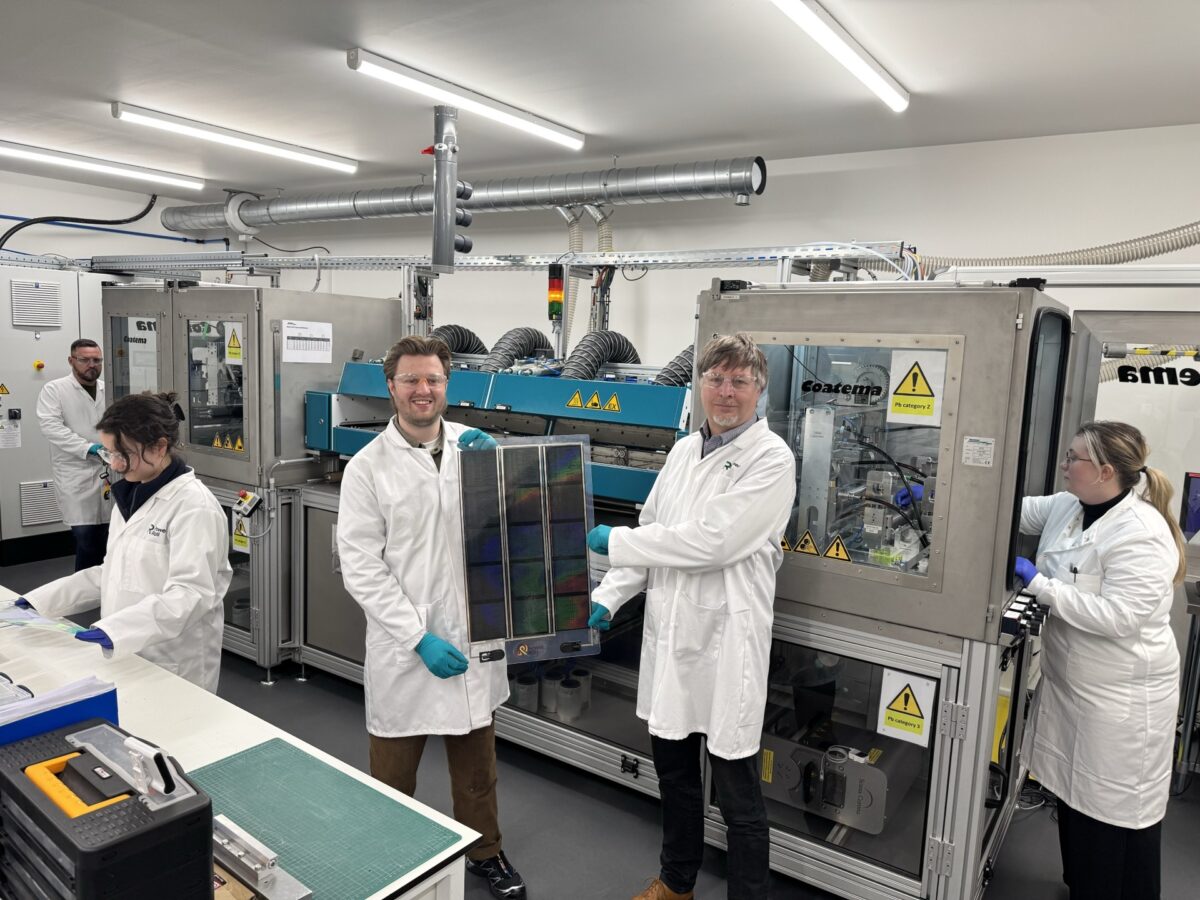A U.K. team has used slot-die coating to make indium-free perovskite solar micro-module devices with a power conversion efficiency of up to 12.8%, based on novel technology from UK solar PV manufacturer, Power Roll.
“Since our previous publication in 2019, we have made significant strides in improving the performance of these modules,” Nathan Hill, senior scientist, Power Roll, told pv magazine, referring to an Energy Environmental Science paper that described 2.63%-efficient serially connected perovskite PV devices based on sixteen 1.6 μm wide V-shaped micro-grooves.
Power Roll has a novel back-contact technique that coats perovskite material on a flexible, lightweight PET substrate, which is embossed with tiny channels or micro-grooves, with a width of less than 2 μm.
“We have developed the technology to include over 300 grooves connected in series, demonstrating power conversion efficiencies of over 12%. To the best of our knowledge, this is the highest efficiency demonstrated for this type of architecture in a perovskite PV device,” said Hill.
Indeed, according to “Back-Contact Perovskite Solar Cell Modules Fabricated via Roll-to-Roll Slot-Die Coating: Scale-Up toward Manufacturing,” published in ACS Applied Energy Materials, the devices had 1.5 μm-width U-shaped grooves this time, and 362 of them were serially connected. Their efficiency was 12.8% after 7 minutes of testing.
The channel’s opposing walls are selectively coated with n- and p-type electron- or hole-selective contacts. These grooves are in turn connected in a series to make micro-modules or cascades.
In the latest research with the University of Sheffield, the team used a UV-curable acrylic, an n-type contact made of a multilayer of titanium/tin(IV) oxide buckminsterfullerene, while the p-type contact was based on nickel/nickel(II) oxide.
The perovskite was MAPbI3, where MA refers to methylammonium, CH3NH3+, noted the team. It was deposited by slot-die coating.
The coated roll was cut into small sections of around 1.5 cm x 1.5 cm. “Each cut section typically contained around 20 cascades, with each cascade comprising 362 serial-connected grooves,” said the researchers.
To investigate the fundamental mechanisms a “new perspective” for the characterization was required, according to Hill. Besides using tools such as scanning electron microscopy (SEM) UV–visible spectroscopy, wide-angle X-ray scattering, the team performed nanofocus X-ray Fluorescence (XRF) at Diamond Light Source, a U.K.-based synchrotron facility. It also used new photocurrent mapping instrumentation at the National Physical Laboratory.
Besides the aforementioned research groups, scientists from Swansea University also participated.
The devices were tested under 1 sun using a calibrated AAA solar simulator. The team found that when the solar simulator was placed underneath the probe station with light projected upward, a photocurrent could be generated whether the device was illuminated from above or through the substrate. Illumination from beneath resulted in higher recorded efficiencies. “This indicates that groove devices can be regarded as a bifacial technology,” it said.
The team highlighted how its approach avoids “scarce elements” such as indium, making it a low-cost solution. “Furthermore, all coating processes explored here were performed using roll-to-roll processing techniques. Our technology is therefore completely scalable and is consistent with high-throughput, low-cost manufacturing.”
“While this paper focuses on small subsections to explore the fundamental functions of the Power Roll architecture, we continue to develop and demonstrate large-area units, on the order of 10 cm × 10 cm, at our site in the North East of the UK,” Hill said commenting on the next steps. “These units contain over 55,000 grooves, and we are working on expanding this technology to even larger modules.”

This content is protected by copyright and may not be reused. If you want to cooperate with us and would like to reuse some of our content, please contact: editors@pv-magazine.com.



By submitting this form you agree to pv magazine using your data for the purposes of publishing your comment.
Your personal data will only be disclosed or otherwise transmitted to third parties for the purposes of spam filtering or if this is necessary for technical maintenance of the website. Any other transfer to third parties will not take place unless this is justified on the basis of applicable data protection regulations or if pv magazine is legally obliged to do so.
You may revoke this consent at any time with effect for the future, in which case your personal data will be deleted immediately. Otherwise, your data will be deleted if pv magazine has processed your request or the purpose of data storage is fulfilled.
Further information on data privacy can be found in our Data Protection Policy.